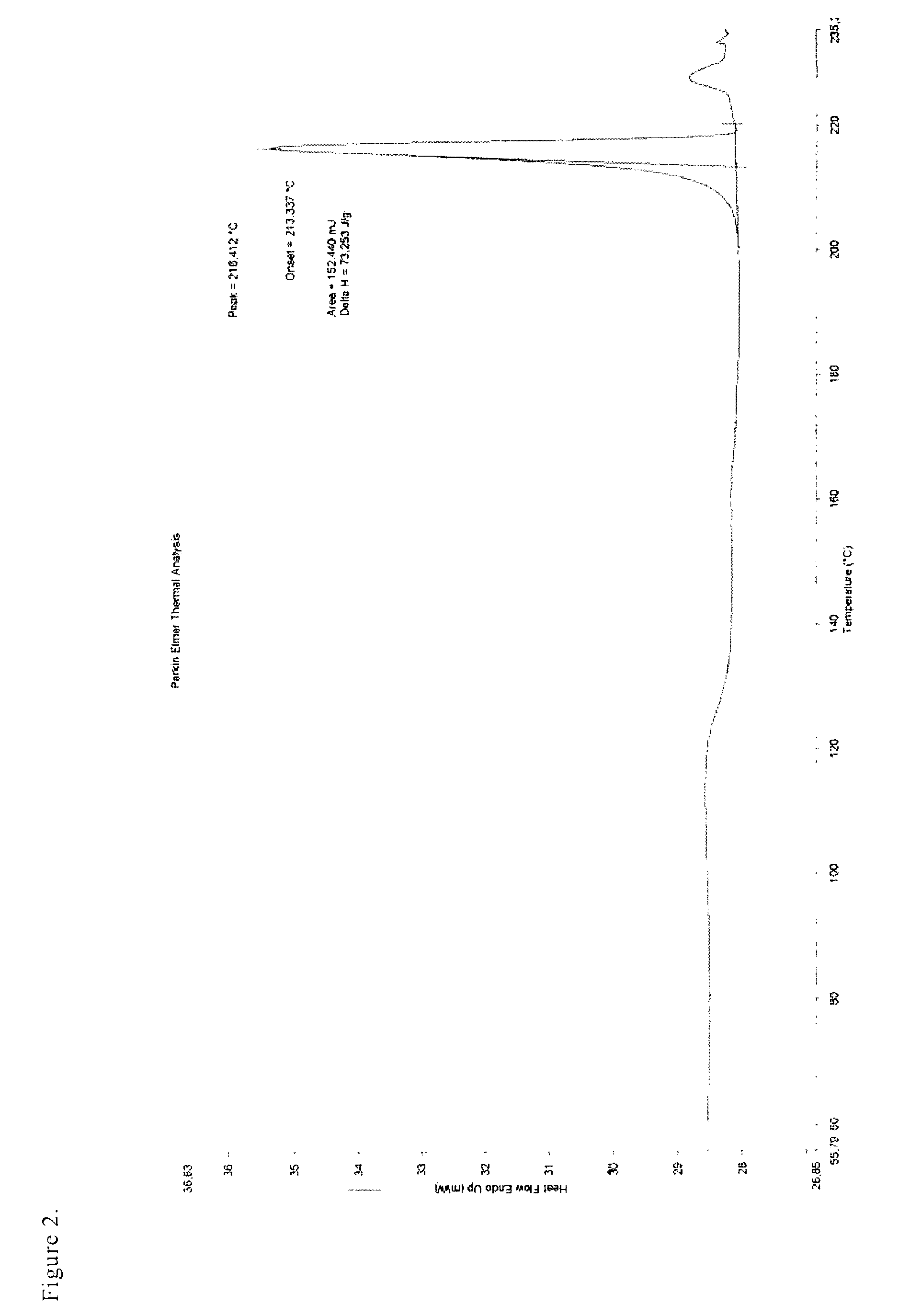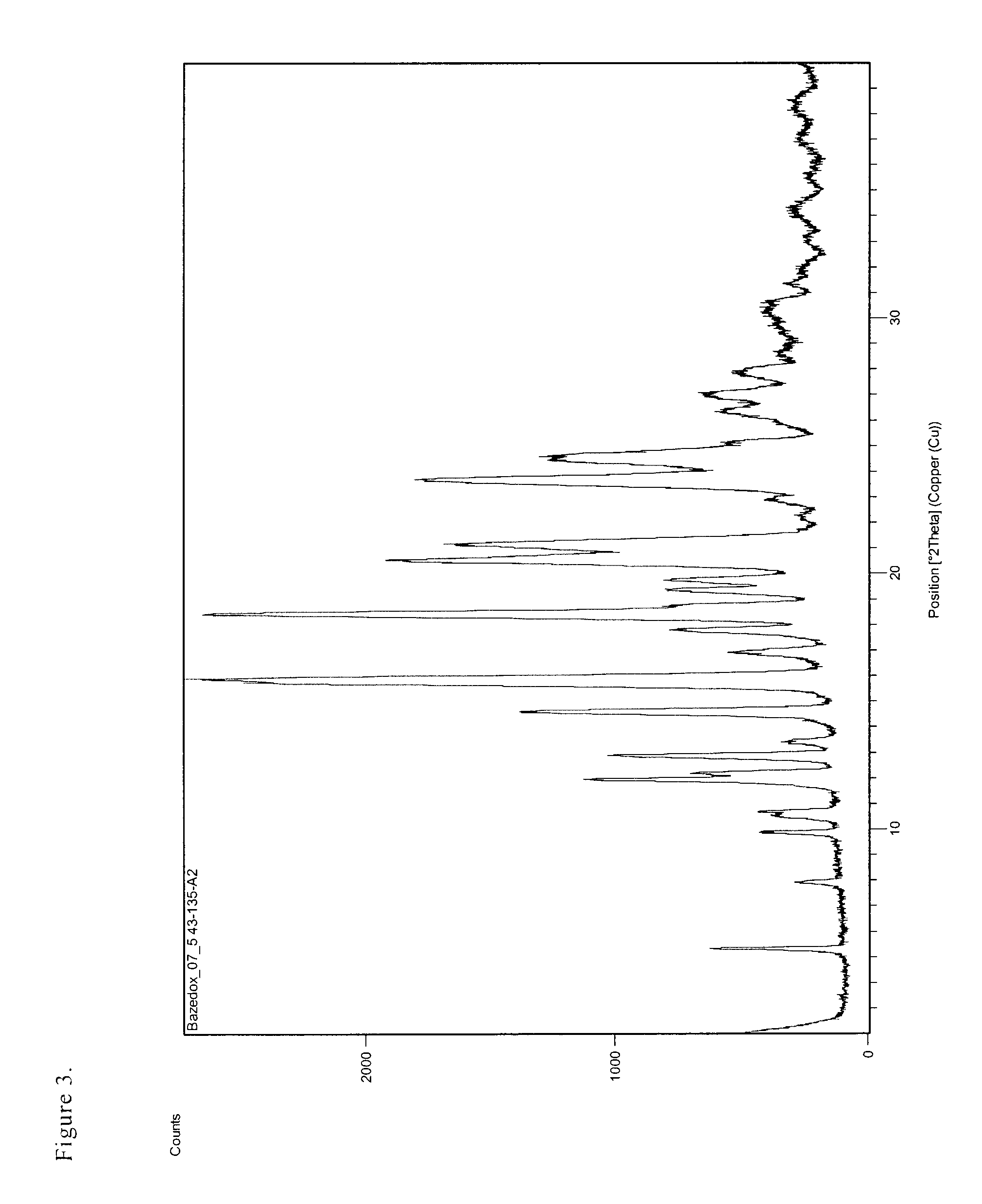Salts of bazedoxifene
a technology of bazedoxifene and salt, which is applied in the field of salt of bazedoxifene, can solve the problems of difficult to achieve international appreciated quality criteria defined by the ich instructions, high demands on substance quality, and amorphous forms of substances are more susceptible to decomposition
- Summary
- Abstract
- Description
- Claims
- Application Information
AI Technical Summary
Benefits of technology
Problems solved by technology
Method used
Image
Examples
example 1
Preparation of 1-[4-(2-azepan-1-yl-ethoxy)benzyl]-2-(4-benzyloxyphenyl)-5-benzyloxy-3-methyl-1H-indole (benzylated bazedoxifene)
[0028]
[0029]In an inert atmosphere NaH (2.7 g; 112 mmol) was suspended in DMF (80 ml). At 0-5° C. 5-benzyloxy-2-(4-benzyloxyphenyl)-3-methyl-1H-indole (11 g; 26 mmol) was added and the suspension was stirred for 30 minutes. Then a solution of 4-(2-azepan-1-yl-ethoxy)benzyl chloride (8 g; 26 mmol) in DMF (30 ml) was added dropwise within 1 hour. The cooling was shut down and the reaction mixture was stirred for another 2.5 hours. Then, water (1.2 ml) was carefully added dropwise to the reaction mixture and the reaction mixture was filtered through a thin layer of celite. Another 35 ml of water were added dropwise to the brightly yellow filtrate under intensive stirring.
[0030]The separated white product was filtered and washed with methanol. The yield of the crude product was 13.7 g (81%). The crude product was dissolved in 70 ml of ethyl acetate with a small...
example 2
Preparation of the Salt of 1-[4-(2-azepan-1-yl-ethoxy)benzyl]-2-(4-hydroxyphenyl)-3-methyl-1H-indol-5-ol with Fumaric Acid in the Proportion of 2 / 1 (bazedoxifene fumarate), polymorph A
[0031]
[0032]The starting compound, benzylated bazedoxifene of formula 7 (4 g; 6.15 mmol) was dissolved in ethanol (40 ml) and the catalyst, 2.34%-Pd / C (0.4 g), was added in an inert atmosphere. Then, the reaction mixture was stirred in the hydrogen atmosphere for 5 hours. The catalyst was filtered off through a celite layer in an inert atmosphere. The obtained clear, colourless filtrate was inoculated with bazedoxifene fumarate of formula 6 (0.1 g). Then, an ethanolic solution (10 ml) of fumaric acid (0.36 g, 3.075 mmol) was added to the solution dropwise within 30 minutes.
[0033]The separated white, crystalline product was filtered and dried in a nitrogen stream at 50° C. 3 g (93%) of the crystalline fumarate (polymorph A) were obtained with the HPLC purity of >99.95%. Melt. point=221-224° C.
example 3
Preparation of the Salt of 1-[4-(2-azepan-1-yl-ethoxy)benzyl]-2-(4-hydroxyphenyl)-3-methyl-1H-indol-5-ol with Fumaric Acid in the Proportion of 2 / 1 (bazedoxifene fumarate), polymorph B
[0034]
[0035]The starting compound, benzylated bazedoxifene of formula 7 (4 g; 6.15 mmol) was dissolved in an ethanol / ethyl acetate mixture (95:5) (40 ml) and the catalyst, 2.34%-Pd / C (0.4 g) was added in an inert atmosphere. Then, the reaction mixture was stirred in the hydrogen atmosphere for 5 hours. The catalyst was filtered off through a celite layer in an inert atmosphere. The obtained clear, colourless filtrate was inoculated with bazedoxifene fumarate of formula 6 (0.1 g). Then, an ethanolic solution (10 ml) of fumaric acid (0.36 g, 3.075 mmol) was added to the solution dropwise within 30 minutes.
[0036]The separated white, crystalline product was filtered and pre-dried in a nitrogen stream and then finally dried in a vacuum drier at the pressure of 15 mbar and temperature of 100° C. 3.1 g (95%) ...
PUM
| Property | Measurement | Unit |
|---|---|---|
| temperature | aaaaa | aaaaa |
| temperature | aaaaa | aaaaa |
| temperature | aaaaa | aaaaa |
Abstract
Description
Claims
Application Information
 Login to View More
Login to View More - R&D
- Intellectual Property
- Life Sciences
- Materials
- Tech Scout
- Unparalleled Data Quality
- Higher Quality Content
- 60% Fewer Hallucinations
Browse by: Latest US Patents, China's latest patents, Technical Efficacy Thesaurus, Application Domain, Technology Topic, Popular Technical Reports.
© 2025 PatSnap. All rights reserved.Legal|Privacy policy|Modern Slavery Act Transparency Statement|Sitemap|About US| Contact US: help@patsnap.com



